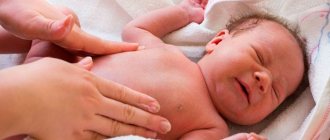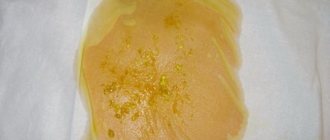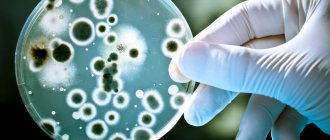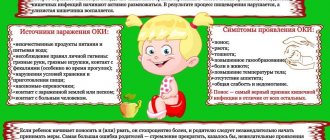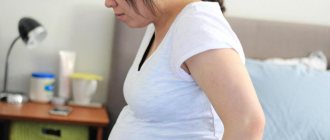Causes
The causes of diarrhea with mucus in a child of any age can be different, but especially often this problem occurs in children under two years of age , when new foods appear in the baby’s diet, the body’s reaction to which can be completely unpredictable. Diarrhea is not an independent disease - it is a symptom that occurs when digestive functions are disrupted or pathological processes develop.
Liquid stool with mucus in a baby of any age, including a newborn, can appear for the following reasons:
- dysbacteriosis, which occurs with digestive disorders, is one of the common causes of diarrhea with mucus and odor in a small child;
- overeating or alternating periods of fasting and eating large amounts of food;
- with a sharp change in the nutrition of a nursing mother, a month-old baby may also experience diarrhea with mucus, since his body is not yet strong enough after birth;
- lactose intolerance, which manifests itself in a child as diarrhea with mucus, but without fever, when consuming dairy products;
- infection with intestinal infection;
- congenital pathological disorders of the digestive tract system;
- the period of eruption of baby teeth in children under two years of age;
- irrational introduction of complementary foods with products that are not suitable for the baby’s age; more about complementary feeding according to Komarovsky →
- severe infectious and inflammatory diseases suffered by a one-year-old child often cause diarrhea with mucus.
What to do?
“Enterosgel” is a sorbent for absorbing and removing toxins from the child’s body
Before going to the hospital if a child has green diarrhea, accompanied by fever, vomiting and deterioration in general condition, parents can be advised to take the following measures.
Give the child Oralit, Regidron, Enterodes in small portions - special saline solutions are sold in any pharmacy and replenish fluid loss. It is not recommended to drink it with plain water: it can only make vomiting worse. In accordance with age, give one of the sorbents: Smecta, Polypefan, Enterosgel. They absorb toxins and promote their elimination. No other medications, especially antibiotics, should be given to a child with green diarrhea before consulting a doctor. This can only worsen his condition. Do not stop breastfeeding, but reduce the daily dose of milk by a third. Do not go on a fasting break for more than 6 hours.
These activities will temporarily alleviate the child’s condition. But you cannot delay calling or visiting a doctor. There is an urgent need to make a diagnosis for immediate treatment.
Clinical manifestations
Symptoms of diarrhea with mucus in a child who is not yet 2 years old can be completely different. The variety of symptoms is caused by various reasons leading to the appearance of mucus in the stool of newborns or older children.
Diarrhea is not an independent disease, but a symptom indicating a disruption of the digestive system of various etiologies. In case of poisoning, in addition to diarrhea with mucus and abdominal pain, the child may also vomit. In this case, the body often indicates that shortly before the illness the baby ate one or another product that could cause this unpleasant condition.
When diarrhea develops with mucus and blood found in a child’s stool, it can often be said that there are cracks or other damage in the rectum. A small patient complains of pain in the anus, which intensifies during bowel movements.
Change in stool color
Often, when poisoning occurs, diarrhea with mucus appears, which has a greenish tint, so thanks to a change in the color of the stool, a similar condition can be detected in a child 2-6 months old. Most often, the green color of the stool indicates that the baby has eaten something stale and spoiled. In rare cases, this color may appear if the child has eaten brightly colored foods or taken antibiotics.
However, if the child is not yet 5 or 6 months old, then if green diarrhea with mucus occurs, dysentery and disruption of the liver enzymatic system should first be ruled out. After all, with the pathological breakdown of bilirubin, stool becomes stained and urine becomes discolored.
Prevention
How to prevent green diarrhea in children? First of all, follow the rules of hygiene. From childhood, teach your child to wash his hands after going outside, after using the toilet, and before eating. Take care of your own hygiene.
The food your family eats must be heat-treated, and water must be boiled or purchased in bottles. Fruits and vegetables must be washed. And, of course, you should not go with your child to places where there may be carriers of infectious diseases.
Source
Diarrhea and blood discharge
Sometimes a child may have diarrhea with mucus and streaks of blood. The most common cause of bloody spots in the stool is hemorrhoids, but in early childhood this is a rather rare occurrence. But still, such a reason cannot be excluded, since in rare situations, even in a child 8 months or less, dilation of the veins of the rectum can be observed, which causes diarrhea with mucus and blood.
Bloody discharge during diarrhea with mucus in a 10-month-old child can be caused by the fact that pathogenic strains of microorganisms live in the intestines, which disrupt its normal functioning and also lead to the formation of cracks in the rectum. Typically, blood in the stool indicates damage to the skin or mucous membrane of the anus, as well as dilation of the hemorrhoidal veins.
Green diarrhea in a child
Green diarrhea that begins in a child invariably causes concern, as does any change in the condition of the baby, the explanation for which you do not know. In this article we will talk about the causes of green diarrhea in a child, and also tell you what to do in such a situation and whether it is worth seriously fearing.
Unusually colored diarrhea can start at any age, but is most concerning in children. Although the child has many more harmless prerequisites for such a change in stool.
Diarrhea with black mucus
Sometimes diarrhea with mucus in a small child under 3 years of age is dark brown and sometimes black in color. This happens if the baby took activated carbon the day before, or is taking a course of taking certain vitamin-mineral complexes that can give such coloring.
If the baby is not yet a month old, his stool may be dark in color and runny in consistency, resembling diarrhea with mucus. In the first week after birth, this is a normal occurrence in an infant, as the baby passes meconium - the original feces, which is a dark mass.
However, in some situations, black feces indicate serious disturbances in the functioning of the body caused by internal bleeding:
- during the oncological process;
- for peptic ulcer of the stomach and duodenum;
- for polyps;
- with dilated veins of the esophagus.
In addition to dark stool, the child has other symptoms that indicate a pathological process. These are complaints of lethargy, weakness and headaches. Anemia can also be detected in a blood test, which is often accompanied by pale skin and dizziness. If you notice any of the above signs, you should consult a doctor. To identify hidden internal bleeding, colonoscopy and FGDS are performed.
How to treat diarrhea in an infant
Prolonged diarrhea in an infant is very dangerous; it leads to dehydration of the child's body in a very short time. What to give a child for diarrhea? First of all, it is necessary to restore the water-salt deficiency caused by diarrhea.
- The child should remain breastfed or bottle-fed. Give the breast as often as the baby asks, do not maintain the usual intervals!
- For formula-fed babies, it makes sense to slightly reduce the portions and feed the baby a little more often.
- If diarrhea in an infant is combined with frequent regurgitation (vomiting), there is no need to engage in amateur activities and treat it yourself. It is urgent to take the child to the hospital, where he will be given an IV, since infants become dehydrated much faster than adults.
- If it's just about diarrhea. You can try to fight dehydration on your own. In addition to the usual food (milk or formula), a child under one year old should drink the same amount per day that he approximately lost with the previous loose stool. Plus the volume of one feeding plus approximately 200 ml for each subsequent loose stool. They should be given special saline solutions (Regidron, Acesol, Oralit); pure baby water or sweet tea for children over one year of age are also suitable. If your baby drinks normally between feedings, give him water from a bottle, spoon, cup or syringe. If things get tough, give 1 teaspoon every 5 minutes.
- If nothing works out, don’t wait for complications and go to the hospital. Criteria for dehydration are drowsiness, dry lips, palms and soles, dull eyes, a poorly straightened fold on the tummy caught in the fingers, lethargy, and lack of urination.
The doctor may also prescribe treatment with Enterofuril, Stop-Diar in suspension, Furazolidone in tablets according to the instructions and dosage according to the child’s age (see symptoms of food poisoning, treatment of food poisoning, causes of diarrhea and vomiting in a child without fever, a complete list of all remedies for diarrhea) . Often, specific Klebsiella or staphylococcal diarrhea is treated with bacteriophages (intestibacteriophage, Staphylococcal, Klebsiella).
Diagnostics
In order to determine why diarrhea with viscous mucus appears in a child, regardless of whether he is 4 months old or 14 years old, you should consult a doctor and undergo certain diagnostic tests.
The results of a general blood test enable the doctor to judge how serious the disease is, accompanied by yellow diarrhea with mucus, that is, to determine the severity of the inflammatory process, on the basis of which treatment is prescribed.
The coprogram reflects the state of the gastrointestinal tract as a whole:
- makes it possible to detect dysfunction of the enzymatic system;
- shows how the pancreas works;
- helps to establish the location of disorders in the gastrointestinal tract;
- reflects the severity of the pathological process.
A significant disadvantage of the coprogram is its low information content, when a small child up to 7-12 months develops an acute form of diarrhea with mucus.
Based on the analysis of stool for the presence of dysbacteriosis, it is possible to determine what types of microbes cause digestive upset, which is important for choosing a method of treating diarrhea with mucus in a child. In this way, Klebsiella, Staphylococcus aureus, Enterococci and Proteus are easily detected.
Also, by analyzing stool, you can determine whether a sufficient number of colonies of lactobacilli and other beneficial microorganisms live in the child’s intestines. The main disadvantage of such a study is the long waiting period for results (7-10 days).
An analysis of stool for worm eggs is also mandatory in a child if he has green diarrhea with mucus, since some types of parasites can lead to periodic diarrhea.
What to do if you have diarrhea with mucus?
If you find that your child has diarrhea with mucus, the first thing you need to do is consult a doctor, this especially applies to infants. But you shouldn’t think that diarrhea in older children will go away on its own.
The most common problem that parents face is dehydration of the child's body. Therefore, in order to prevent the development of such a condition, it is necessary to maintain a drinking regime. Even if the child is less than 6 months old and is exclusively breastfed, the appearance of diarrhea with mucus is a direct indication to start giving him water.
How can you treat diarrhea with mucus at home in a child? Before the doctor arrives, it is allowed to give as much fluid as possible, while limiting food for a while. If the baby is hungry, you can offer him white bread crackers, crackers, or hard cookies.
It is prohibited to prescribe medications on your own, since green or bloody diarrhea with mucus that develops in a child can be a symptom of a serious illness that requires specific therapy. Taking anti-diarrhea pills can hide some important diagnostic signs, making it much more difficult to identify the causes of the condition.
Treatment
Let us remind you that only a doctor can prescribe the medications that the baby will be treated with. Before his arrival, only antipyretics (paracetamol), sorbents (Smecta, Enterosgel, etc.) and rehydration solutions to prevent dehydration (Regidron, Oralit, Ringer's solution) are allowed.
- Therapy for dysbiosis is carried out with the help of probiotics and prebiotics, drugs that will have a positive effect on the intestinal microflora. For the treatment of children, you can purchase Linex, Hilak-Forte, Bifidum-bacterin. You can also use whey; it contains a huge amount of beneficial bacteria.
- For intestinal infections, the course of treatment is prescribed depending on the pathogen. For example, with a widespread rota virus, children are prescribed interferon, Anaferon or rectal suppositories Viferon; in case of bacterial attack - antibiotics based on ciprofloxacin and intestinal antiseptics
- Antidiarrheals that inhibit peristalsis (Loperamide, Imodium, Diarol)
- Antispasmodics to relieve pain (No-spa, papaverine)
When is medical attention required?
If diarrhea with clear mucus appears in a child whose age is from 1 to 5 years, then if the following accompanying signs are detected, you should immediately consult a doctor:
- Watery, rice-like diarrhea and bloody stools.
- The frequency of bowel movements exceeds 6-8 times a day, or the child defecates a third or more times in an hour.
- Other bowel dysfunctions include nausea, vomiting, tenesmus (painful urge to go to the toilet).
- Body temperature exceeds 37.5 °C.
- Signs of an inflammatory or infectious disease are fever, chills, body aches.
- Dry mouth, severe thirst.
- Apathy and lethargy.
- Sticky skin.
- Excessively pale skin.
- Refusal to drink and eat.
- Rare and scanty urination.
All of these symptoms may indicate not only the development of dehydration, which is one of the dangerous consequences of diarrhea with mucus in a child under one year of age, but also the presence of a serious infectious disease, therefore, if such signs are detected in an infant, it is necessary to call an ambulance.
It doesn’t matter how old the child is - 3 months or 3 years old, diarrhea with mucus can occur at any age. In such a situation, you do not need to self-medicate, but should consult a doctor to determine the causes of the condition and prescribe appropriate therapy.
Author: Violeta Kudryavtseva, doctor, especially for Mama66.ru
How to understand that loose stools are diarrhea (diarrhea)
First, let's talk about norms.
- In a breastfed baby, stool can accompany each feeding, up to 8 times a day.
- When bottle-fed, babies have stools less often, up to 4 times a day.
- After the introduction of complementary foods, the frequency of bowel movements approximately equalizes, both in children who are still fed breast milk and in babies receiving formula, more often - up to 3 times a day.
When breastfeeding, stool can be either liquid or mushy; the consistency and shade of stool depend on what is present in the nursing mother’s diet; the smell is somewhat similar to the smell of kefir.
Thus, watery stool with a greenish tint in a baby feeding at the breast, with lumps of undigested milk, is the norm, but only if the baby feels well, is gaining weight and behaves normally!
The stool of a child fed formula is denser, almost always the same color and characteristic smell.

